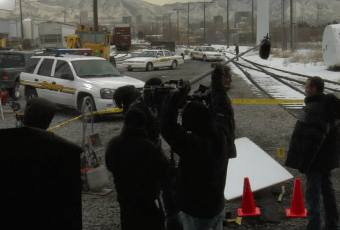Online Film School Free » Film Directing Course » The Master Scene Method
Master Scene Shooting in Filmmaking - Your Ultimate Guide
Table of Contents
Toggle
A master scene setup anchors your film’s geography, tone, and performance in a single wide “master shot” before you dive into closer angles and coverage. Let’s explore how it works and why it’s a must-have tool for directors.
What is the Master Scene (Master Shot) method?
A master scene refers to a structured shooting method where you film an entire scene from a wide perspective before capturing closer shots. This method ensures spatial continuity, consistent performances, and editorial flexibility in post-production.
- The core of a master scene is the master shot – a wide, uninterrupted take showing character placement, movement, and set geography.
- It serves as a visual and narrative anchor from which all coverage derives.
For example, in the pencil-eraser scene we see here in the picture, we will shoot the full scene from this wide angle

And only after we will finish shooting all the scene from the wide-angle, we will start breaking it down to different shot such as this Medium shot

Master Scene Method vs. Scene-by-Scene Rehearsal
In the Master scene method you shoot the full scene wide, then add coverage (OVS, cutaways, close‑ups). In a Scene-by-scene the rehearsal focus on individual beats or moments first, sometimes without a wide establishing shot. The former is ideal for maintaining spatial clarity and performance consistency; the latter works for more fragmented, beat-driven scenes.
Master Shot vs. Master Scene: What’s the Difference?
- Master Shot – A specific camera take – the wide shot that captures the full scene.
- Master Scene – The overall workflow and structure: starting with the master shot, then layering in close-ups, cutaways, and inserts.
The master shot is a component of the master scene – it’s not just a visual; it’s a directorial and editorial planning tool.
Master Scene – Technique & Workflow
Planning the master scene
- script breakdown – Planning a master scene effectively starts with a script breakdown, which is essential for understanding the core geography of the scene. Directors must identify character entrances and exits, moments of emotional or narrative emphasis, and physical interactions between characters or props. This initial step informs how you block the actors and plan the camera movement within the frame. Skipping this stage often results in scenes that feel visually flat or logistically messy.
- rehearsals – Once the blocking is conceptually clear, rehearsals should be staged within the full width of the area that the master shot will cover. This isn’t just about performance, it’s about spatial consistency. Actors need to know their marks in a wide composition, where movements can’t be “cheated” as easily as in close-ups. These rehearsals also allow the director and cinematographer to observe how action unfolds organically, which can influence later coverage decisions.
- shot listing – Following rehearsals, shot listing should detail the entire sequence, beginning with the master shot and leading into planned coverage (e.g., over-the-shoulder shots, close-ups, inserts). This prevents unnecessary improvisation on set and ensures coverage aligns with the visual language of the master shot.
Setting Up a Master Shot – Step-by-Step
- Scout the location and build a storyboard – This establishes not only the visual design of the scene but also practical constraints like lighting access, blocking space, and sound control.
- Positioning the camera – Your target is capturing the full range of action clearly while respecting character eyelines and spatial coherence. Poor eyeline matching or unclear spatial relationships in the master shot can cause major continuity issues in editing.
- Framing the action – include key entrances, actors, and props within the shot without overcrowding the frame. A master shot must be visually legible and emotionally grounded. Before recording the actual take,
- So a test roll- It is critical to verify exposure, focus, and sound integrity. Any technical mistake in the master shot can ripple through all your coverage, forcing costly reshoots or awkward edits.
Best Camera Movement for a Master Scene
Camera movement in a master scene should serve the story, not distract from it.
A static camera is often preferred because it emphasizes performance and staging without introducing continuity risks. However, dolly or slider movements can be used to subtly track character motion or shift perspective within the same shot, offering a more cinematic feel while retaining coherence. For more fluid dynamics, a Steadicam allows for smooth, immersive motion that follows characters without cutting, though it requires careful choreography to avoid disorienting the viewer.
Crucially, avoid overcomplicated or erratic movements. An over-active camera can cause problems with coverage alignment and confuse the audience’s understanding of space and continuity.
Lighting a Wide Master Shot
Lighting a master scene is particularly challenging due to the breadth of the frame. A balanced approach typically involves layering a key light, fill light, and background illumination, ensuring the subject stands out while preserving the depth and believability of the environment. Since you’re covering more space than in close-ups, use soft light to avoid harsh falloff and unflattering shadows at the edges of the frame.
Incorporating practicals – on-screen light sources like lamps or sconcesnot – only helps to justify the lighting scheme but adds realism and depth. For additional finesse, “motivated lighting” hidden behind set elements (such as flags or architectural features) can subtly guide viewer attention and enhance the cinematic texture.



